The STWBC-MC is our first Qi Extended Power Profile (i.e., EPP or 15 W) 1.2.4 wireless charging transmitter and our first device to manage up to three coils to offer a much larger charging surface. This new component is highly symbolic because it represents an important milestone in our wireless charging strategies over the years. Indeed, we started with the STWBC, which was our first Qi transmitter, and quickly followed with the STWBC-WA that brought wireless charging to wearables and other small devices thanks to a coil as small as one centimeter. The next step came last year when we introduced our first 15 W charging solution, the STWBC-EP, and we are now expanding on that technology by offering the ability to use more coils.
Charging Multiple Devices?
The STWBC-MC won’t be our only Qi 1.2.4 component since we will update the firmware of our STWBC-EP to bring our one-coil 15 W solution to the upcoming standard. This new Qi version is a minor update, but it brings essential features such as simpler power profiles for 5 W and 15 W solutions. It also forces manufacturers to pass more stringent thermal and electrical tests to ensure even safer products. That means tolerating higher temperature when charging at 15 W and handling higher voltage spikes than in the previous versions of the standard. Safety and efficiency are the two major pillars of wireless charging transmitters, and three-coil models must handle more complex situations and protect the user against a wider array of malfunctions.
Additionally, given the current conversation on wireless charging, we must also explain that more coils don’t necessarily mean the ability to charge multiple devices at once. The Qi standard has no specification for such a use case, and there are still significant challenges. As we’ll see, having multiple coils active negatively affects performance, and there are inherent physical limitations that cause overheating and a loss of efficiency, especially when prototypes try to use between 10 and 20 coils. There are charging solutions that can transfer power to multiple devices, but they currently utilize many one-coil transmitters, and they aren’t compatible with proprietary fast charging solutions. As a result, our three-coil transmitter charges a single device at once, but it also includes various technologies to guarantee performance, like our presence detection scheme.
Smart and Future-proof

The STWBC-MC embarks a new presence detection scheme to better perceive the coil that’s the closest to the receiver. This step must be fast and precise because if more than one coil starts resonating, it creates an important magnetic field that can affect performance. Additionally, other coils could register as foreign objects, and the transmitter must ignore them to continue charging operations. Turning them off also means that any metallic objects sitting next to the product charging won’t disturb the power transfer. As a result, once the system determines which coil works best, it shuts down the others, but the presence-detection scheme doesn’t stop there. It continually checks the location of the product wirelessly charging because if it moves, the transmitter can start using another and more effective coil to maintain the efficiency and performance.
The STWBC-MC and STWBC-EP also distinguish themselves from the rest of the industry by integrating a digital DC-DC converter for fixed frequency operations. Traditionally, competing devices use an external converter, but by incorporating it onto the silicon, we help engineers reduce their bill of material, and simplify their design. This feature also works to keep the transmitter’s frequency below 148.5 kHz. Very soon, an update to the European Union’s Radio Emission Directive (RED) will limit H-field emission to -5 dBm when transmitters utilize frequencies higher than 148.5 kHz. To meet these more stringent requirements, we used our embedded digital DC-DC controller to set the fixed frequency operation to 127.7 kHz.
The Wireless Charging Universe
Working at this operating frequency also allows us to step into the world of proprietary fast charging. For instance, 127.7 kHz enables us to comply with the 7.5 W standard conceived by the world’s most profitable smartphone manufacturer, hereby reducing charging times for a better experience and less stress on the battery. Similarly, the most prominent Asian smartphone manufacturer also set specific rules for its wireless fast-charge protocol. It uses proprietary packets within standard Qi communication to increase the power level to 10 W while keeping backward compatibility with legacy 5 W chargers.
Both the STWBC-EP and the STWBC-MC can handle these proprietary packets, which means that our STEVAL-ISB047V1 evaluation board can be the first step in developing a charging solution compatible with all these massively important fast-charging techniques: 15 W with Qi EPP terminals, 7.5 W with devices requiring 127.7 kHz fixed frequency, and 10 W with products using proprietary packets. We can thus start to expect truly universal wireless charging solution by third-party accessory manufacturers.
ST’s Unique Triple Pass Demodulation
A transmitter must be highly responsive to adapt to the presence of foreign objects and to react to a product that could either change position or leave the charging mat. Ergo, the Qi standard ensures constant communication between the transmitter and receiver through the exchange of messages, which are modulations in the power transfer that the controllers then demodulate and process. These messages are crucial and missing even just one of them will force the transmitter to halt charging operations and wait until it can reestablish a connection with the receiver. For the end user, that translates into a poor user experience where the charger stops and then starts charging again for no apparent reason.
To prevent this issue and offer a superior device, we developed a patented demodulation technique that relies on a triple pass. We are the only ones providing this technology, and it is available on our STWBC-EP and STWBC-MC. Our transmitters can demodulate a message by reading the current, voltage or phase of the signal coming from the charging product, and our IC dynamically chooses the source (a pin on the transmitter) with the cleanest and strongest signal. What that means is that if the phone moves, or conditions change, and one pin becomes too noisy, the transmitter can use the others to offer a perfect continuity of communication with the receiver.
The Ultimate Efficiency of our Qi Transmitter

Checking if a product can send and receive messages isn’t the only way to determine if it is compatible with a Qi transmitter. Foreign Object Detection (FOD) is a critical mechanism that’s always checking what’s on the charging surface to prevent catastrophic failures. And to determine if a product merits a power transfer, Qi partly relies on the Q-Factor or Quality factor ($latex Q$). This value represents the “ratio of the apparent power to the power loss,” according to the Wireless Power Consortium.
Very simply, $latex Q = \frac{\omega L}{R}$, where $latex \omega$ is a function of the frequency ($latex f$) such as $latex \omega = 2\pi f$. $latex L$ is the inductance and $latex R$ is the resistance. Ideally, $latex Q$ is infinite, meaning there are no losses, but commercial coils score around 100. Therefore, when metallic objects, like keys, or coils of poor quality, register a number close to 0 because their power losses are so great ($latex R$ is too high), the transmitter knows it is dealing with a foreign object and prevents the system from transmitting power. A precise FOD is key to an excellent efficiency and waste elimination.
Another challenge of a multiple-coil system is the loss of efficiency. Wireless charging started with one coil because it was easier to optimize the resonance of the receiver and transmitter, which led to higher power efficiency. Thus, theoretically, using multiple coils means a loss of precision, and ergo, higher power losses. However, in practice, we can compensate for the imprecision to guarantee the same performance and user experience as a single-coil solution. The charging module will get the same power, there’s no increase in temperature, and changes in efficiency are so minimal that the user experiences the same charging times as with a single-coil system.
Making Life Easier

To help engineers take advantage of all these features, we offer the STEVAL-ISB047V1, an evaluation board integrating the STWBC-MC. It comes with a bill of materials and schematics so design teams can transpose our Qi transmitter onto their PCB faster. We can also announce that we already passed the preliminary Qi 1.2.4 tests and will obtain the certification for our new evaluation board by the end of the year. Since Qi is a system-wide standard, transposing our platform on a custom PCB dramatically facilitates the various approval and regulatory processes, thus reducing the time to market. The board even comes with a dongle that connects to a PC to offer a Graphical User Interface, the STSW-STWBCGUI, so developers can monitor power transfers, get error messages, and quickly configure the application.
The STEVAL-ISB047V1 also differentiates itself from our other wireless charging evaluation boards by offering our first USB Type-C sink-only power delivery connector that utilizes our STUSB4500 controller. What this means is that engineers have all the tools to create a modern wireless charger that gets power from the mains by using a USB-C cable. There’s also a DC barrel and a standard micro-B USB connector so teams can choose the input that makes the most sense for their design. However, by choosing USB-C, they benefit from a more robust and user-friendly connector. Finally, the STWBC-MC can implement proprietary fast charging protocols from manufacturers that want to offer additional features to their customers, making our reference design highly malleable.
- Learn more about the STWBC-MC
- Learn more about the STEVAL-ISB047V1
